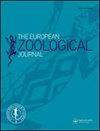地中海蓝贻贝(Mytilus galloprovincialis Lamarck)本地居群的分子遗传分化及其与环境变量的关系
IF 1.4
4区 生物学
Q2 ZOOLOGY
引用次数: 5
摘要
蓝贻贝是潮间带和潮下带重要的生态系统工程师。贻贝的分布受到许多底栖和远洋环境变量(例如,基质类型和可得性、水运动、浮游植物生产、物理干扰)以及这些变量之间的相互作用的影响。由于地中海贻贝对环境变化的广泛耐受性,它在所有蓝贻贝中具有最大的殖民新地理区域的能力。了解群体遗传变异如何与环境变异相关或由环境变异引起是很重要的,但长期以来一直是一个挑战。本研究利用53个单核苷酸多态性(SNP)位点,对地中海、黑海和亚速海地区加洛省支原体种群的遗传分化进行了研究。对来自36个地点的1004只贻贝进行了基因分型,并与来自11个参考点的贻贝SNP数据进行了结合。fst值的两两比较、对应分析(CA)和结构分析均显示出4个种群:大西洋;西地中海;爱琴海;以及亚速海、黑海和马尔马拉海。来自阿尔及利亚(西奥兰)的一个种群介于地中海和大西洋的两个主要种群之间。海景遗传分析采用GLM和DistLM分析来检测13个环境变量的位点特异性遗传变异。GLM确定了五个环境变量,解释了特定地点fst值的变化,而在DistLM最佳拟合模型中,只有四个是显著的。这些分析表明,环境变量的复杂组合有助于解释地中海内加洛省支原体种群的遗传变异,这很可能反映了地中海区域子盆地之间形成、隔离和重新连接的复杂地质历史。本文章由计算机程序翻译,如有差异,请以英文原文为准。
Molecular genetic differentiation of native populations of Mediterranean blue mussels, Mytilus galloprovincialis Lamarck, 1819, and the relationship with environmental variables
Abstract Blue mussels of the genus Mytilus are important ecosystem engineers in intertidal and subtidal communities. The distribution of Mytilus mussels is influenced by a number of benthic and pelagic environmental variables (e.g., substratum type and availability, water movement, phytoplankton production, physical disturbance) as well as interactions between these variables. Because of its broad tolerance of environmental variation the Mediterranean species, Mytilus galloprovincialis, has the greatest ability of all blue mussels to colonise new geographic regions. Understanding how population genetic variation is related to, or caused by, environmental variation is important but has long been a challenge. The present study examined the genetic differentiation of native populations of M. galloprovincialis throughout its entire geographic range in the Mediterranean Sea, the Black Sea and the Sea of Azov using 53 single nucleotide polymorphisms (SNP loci). Mussels, in total 1004 individuals collected from 36 locations, were genotyped and combined with existing SNP data for mussels from 11 reference sites. Pairwise comparisons of F ST values, correspondence analysis (CA) and STRUCTURE analysis all revealed four groups of populations: the Atlantic Ocean; the western Mediterranean; the Aegean Sea; and the Azov, Black and Marmara Seas. One population – from Algeria (Oran West) – was intermediate between the two main groups of the Mediterranean Sea and Atlantic Ocean. Seascape genetic analyses using GLM and DistLM analyses were employed to test site-specific genetic variation as a function of 13 environmental variables. The GLM identified five environmental variables that explained variation in site-specific F ST values, whilst in the DistLM best-fit model only four were significant. These analyses suggest that a complex mix of environmental variables contribute to explaining genetic variation of M. galloprovincialis populations within the Mediterranean Sea, which most likely reflects the complex geological history of formation, isolation and reconnection among the regional sub-basins of the Sea.
求助全文
通过发布文献求助,成功后即可免费获取论文全文。
去求助
来源期刊

European Zoological Journal
Agricultural and Biological Sciences-Animal Science and Zoology
CiteScore
3.10
自引率
5.60%
发文量
80
审稿时长
30 weeks
期刊介绍:
The European Zoological Journal (previously Italian Journal of Zoology) is an open access journal devoted to the study of all aspects of basic, comparative and applied protozoan and animal biology at molecular, cellular, tissue, organ, organismal, population, and community-ecosystem level. Papers covering multiple levels of organization and integrative approaches to study animal form, function, development, ecology, evolution and systematics are welcome. First established in 1930 under the name of Il Bollettino di Zoologia, the journal now has an international focus, reflected through its global editorial board, and wide author and readership.
 求助内容:
求助内容: 应助结果提醒方式:
应助结果提醒方式:


